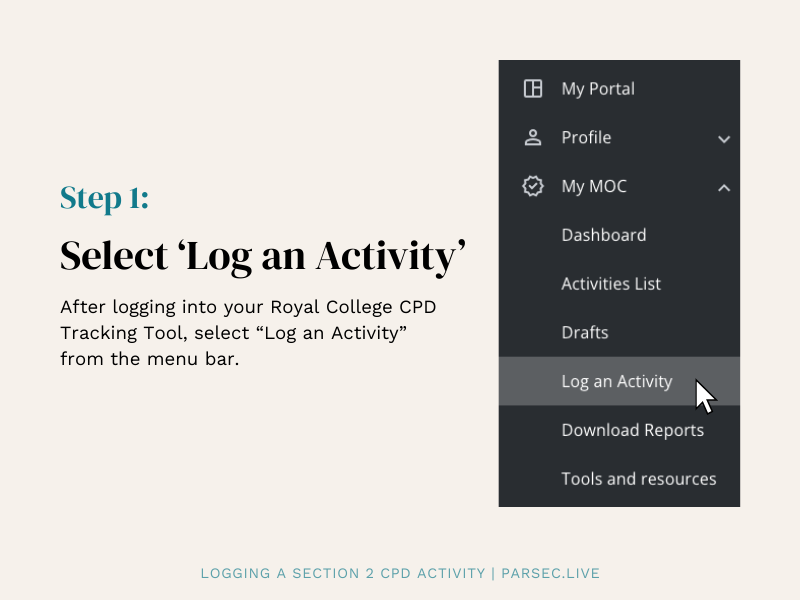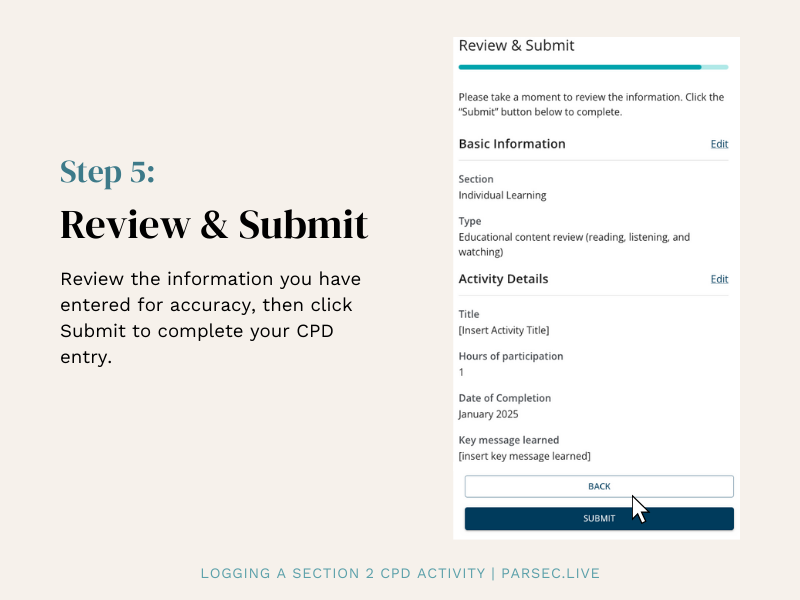FOR CANADIAN CERTIFIED PHYSICIAN ASSISTANTS (CCPAs)
Claiming CPD Credits for PARSEC Activities
PARSEC offers educational events that qualify for Continuing Professional Development (CPD) credits through the PACCC and other recognized bodies.
Depending on your participation, events can be claimed as either Section 1 (group learning) or Section 2 (self-directed learning):
-
Section 1 CPD Credits - Live Attendance
To be eligible for Section 1 credits, you must:
• Attend the session live, or watch the replay within 2 weeks, and
• Complete the evaluation form within 2 weeks of the live event
__📨 CPD certificates will be issued by email to qualifying participants within two weeks.
⏳ After the 2-week window, the session can no longer be claimed as Section 1, and instead can be claimed as section 2.
-
Section 2 CPD Credits - Replay Viewing
If you miss the live session or don’t complete the evaluation form in time, you can still claim the activity as Section 2 (self-directed learning):
• Watch the recorded replay
• Log it in through the CPD tracking tool
• Include date, topic, and a brief reflection or key learning
__No certificate is provided for Section 2 credits.
GENERAL CPD QUESTIONS
CPD Credits 101
-
CPD stands for Continuing Professional Development. It refers to the ongoing learning activities that help healthcare professionals maintain competence and stay current in their field.
-
CPD is part of a lifelong learning process that ensures safe, effective, and evidence-informed practice. While not all Canadian employers mandate CPD tracking, it is required to maintain the Canadian Certified Physician Assistant (CCPA) designation.
-
CPD credit hours are units used to measure professional learning. The number of hours credited depends on the activity type (e.g., live participation vs. self-learning).
-
The Physician Assistant Certification Council of Canada (PACCC) bases its CPD categories on the Royal College of Physicians and Surgeons of Canada’s Maintenance of Certification (MOC) framework.
This means that most learning activities recognized by the Royal College are also accepted when maintaining your Canadian Certified Physician Assistant (CCPA) designation.
Here’s a breakdown of the main categories:
🔹 Section 1: Group Learning Activities
These require live, interactive participation with opportunities to engage in discussions, ask questions, or reflect with peers.
Examples include:
Live webinars
Conferences and symposia
Panel discussions and expert roundtables
Journal clubs
Case-based discussions
Rounds and small group learning
Interactive simulations
🧾 Live attendees typically receive a certificate of completion.
🔸 Section 2: Self-Learning Activities
These are independent activities completed at your own pace, without live interaction.
Examples include:
Watching recorded webinars or educational videos
Reading journal articles or clinical guidelines
Listening to medical podcasts
Reviewing online modules or recorded conferences
Exploring clinical topics for personal learning
📝 No certificate is required to log these; simply document the activity in your CPD tracker.
🔷 Section 3: Assessment Activities
Less commonly used by PAs, these activities involve structured assessment and feedback.
Examples include:
Peer feedback
Self-assessment programs (SAPs)
Chart audits or practice evaluations
Simulation assessments with feedback
360-degree evaluations
___
PACCC accepts a wide variety of learning formats as long as they align with recognized categories and support your professional development.
-
Canadian Physician Assistants track their CPD (Continuing Professional Development) through an online platform, using the Royal College of Physicians and Surgeons of Canada’s CPD Activity Tracking Tool.
This system is widely used by healthcare professionals across Canada.
-
To maintain your Canadian Certified Physician Assistant (CCPA) credential, you are expected to regularly engage in CPD activities over a multi-year cycle, as outlined by the Physician Assistant Certification Council of Canada (PACCC).
While specific credit totals and timelines may vary slightly over time, CCPA holders are generally required to:
Earn CPD credits on an annual basis
Track activities across recognized learning categories
Submit evidence of ongoing professional development to remain in good standing
___
📎 For the most current CCPA maintenance requirements, visit the official PACCC website.

CPD Requirements for Physician Assistants in Canada.
Learn more about the Maintenance of Certification (MOC) requirements as outlined by the Physician Assistant Certification Council of Canada (PACCC).
-
The Physician Assistant Certification Council of Canada(PACCC) is an independent body under the Canadian Association of Physician Assistants (CAPA) responsible for administering the national certification process for PAs in Canada. This includes the PA Entry to Practice Certification Exam, which is required upon graduation from a recognized Canadian PA program. The exam is conducted independently of training institutions to ensure fairness and alignment with national standards, as outlined in the Entrustable Professional Activities for PAs (EPA-PA).
PACCC plays a key role in maintaining public trust by ensuring that certified PAs meet consistent, high-quality standards of care. The Council is made up of representatives from across the healthcare system, including certified PAs, physicians, regulators, educators, allied health professionals, and public members, along with the Chairs of the Continuing Professional Development and Test Committees.
-
MOC stands for Maintenance of Certification — a structured program designed to support ongoing professional development for healthcare professionals after initial certification.
MOC is the framework used by the Royal College of Physicians and Surgeons of Canada and recognized by the Physician Assistant Certification Council of Canada (PACCC) to help practitioners stay current and competent throughout their careers.
For certified PAs, MOC involves:
Tracking CPD (Continuing Professional Development) activities across three sections:
Section 1: Accredited group learning (e.g., conferences, live webinars)
Section 2: Self-directed learning (e.g., journal reading, recorded webinars)
Section 3: Assessment activities (e.g., peer feedback, chart audits)
Documenting learning using the Royal College CPD Tracking Tool
Meeting minimum CPD credit requirements over a 5-year cycle
The goal of MOC is to ensure high standards of care by encouraging reflective practice, lifelong learning, and evidence-based clinical improvement.
FREQUENTLY ASKED QUESTIONS
Claiming CPD for PARSEC Activities
-
Yes. Access to all CPD-eligible PARSEC events (including live Journal Clubs, Virtual Shadowing, and Panel Discussions) is exclusive to registered members.
This allows us to:
Verify participation
Provide proper CPD documentation
Maintain a consistent standard for credit eligibility
Ensure events are tailored to the Canadian PA community
If you're not yet a member, you can join today at www.parsec.live/join.
-
Yes. In order to claim CPD credit for PARSEC-hosted events, you must be a registered PARSEC member. CPD tracking and certification is available only to members who participate through our official platform.
When you attend an event as a member:
Your attendance is verified
You are eligible to receive a Certificate of Completion (for live, eligible events)
You’ll have access to logging instructions, session details, and downloadable resources
-
You can register in just a few steps:
Visit our website: www.parsec.live/join
Choose your membership level (e.g., General, Student, Faculty)
Complete the registration form
Once registered, you’ll receive access to:
Member-only events
CPD-eligible sessions
Research tools and recorded content
Your personal login area for event history and resources
Your membership ensures you’re recognized for your participation and can claim CPD credit with supporting documentation.
-
PARSEC applies for individual CPD accreditation for select live events through PACCC. When approved, these events are formally recognized as eligible for CPD credit toward maintaining your CCPA designation.
When PARSEC applies for and receives CPD accreditation through PACCC for a live event, it will be clearly stated in the event description.
If an event is CPD-accredited through PACCC:
The number of approved CPD credit hours will be specified in advance
Attendance will be verified by PARSEC
You will receive an official certificate of participation indicating the number of PACCC-accredited hours you’ve earned
These hours can be submitted directly toward your CCPA maintenance requirements
Look for This in Event Details:
PACCC Accredited (noted clearly on the registration or event page)
Credit Hours Approved (e.g., “This session is accredited for 1.0 CPD hour”)
Attendance Will Be Verified (e.g., “To receive credit, you must attend live with your full name visible and stay for the duration of the session”)
-
These are live, interactive sessions where learning happens in real time with others. To qualify for Section 1 credit, the session must:
Be scheduled in advance
Include interactive elements (e.g., Q&A, discussion, polling)
Be facilitated or moderated
Examples of Section 1 activities:
PARSEC Journal Club (live attendance)
PARSEC Virtual PA Shadowing (live)
Expert Panel Discussions (live)
Conferences, Rounds, or Accredited Small Group Learning
💡 You typically earn 1 credit per hour, and must be able to verify attendance (e.g., Certificate of Completion).
-
These are asynchronous, independent learning activities completed on your own schedule. They don’t require interaction with others or a facilitator.
Examples of Section 2 activities:
Watching a replay of a PARSEC event
Reading journal articles, guidelines, or research
Exploring content in the PARSEC Research Hub
Listening to medical podcasts or educational videos
Conducting self-directed research
💡 You also earn 1 credit per hour for Section 2 activities. No certificate is required, but you should log the date, title, and learning outcome.
-
A CPD Certificate or Letter of Attendance from PARSEC is only provided for live, eligible events where:
The event has been officially accredited by the Physician Assistant Certification Council of Canada (PACCC) or
The session meets the criteria for Section 1: Group Learning (live, interactive, and attendance can be verified)
✅ You will receive a PARSEC CPD certificate if:
Attend the live session or watch the replay within 2 weeks
Submit the CPD form within 2 weeks of the live event
❌ PARSEC CPD Certificates are not provided for:
You are watching a CPD replay more than two weeks after the live CPD event takes place.
Reading materials or articles
Other Section 2: Self-Learning activities
These activities can still be logged for CPD credit, but a certificate is not required for Section 2 submissions.
-
No. You are responsible for logging your own credits using your preferred CPD tracking system (e.g., Royal College or PACCC log). PARSEC provides certificates and session details to support your entries.
STEP-BY-STEP TUTORIAL
Submitting your CPD Hours
Logging Section 1 CPD Credits
Logging Section 2 CPD Credits











